When I first started playing Minecraft, I spent most of my time, well, mining. Or at least underground: I’d obsessively dig stairs going straight through the rock in one direction or another, I’d occasionally hollow out a blocky room whenever I needed a space for a chest or a crafting table, and every once in a while, I’d run into a natural cave, some of which were mundane and others of which were spectacular.
Eventually, though, I got bored (or perhaps overwhelmed) with those underground caves, so I decided to work on a house. I didn’t head outside to do that, however: the opening of my mine was at the base of a fairly large hill, so I decided to hollow out the space above the entrance into a room.
Since I was working above ground, I hit the side of the hill fairly soon, so I put in a window. And, as I continued to enlarge that room, I hit another side of the hill; following my Christopher Alexander fetish, I recognized this as Light on Two Sides of Every Room.
One of Christopher’s Alexander’s main points is that you shouldn’t design buildings in isolation, you shouldn’t design them abstractly: you should design them in context, you should design each building so that the area around it is made richer by the presence of that building. And one of the wonderful aspects of Minecraft is that it’s a building game that encourages such an approach. Yes, if you want, you can build in Minecraft as if you were working with Legos, assembling the blocks that you have at hand into whatever shapes you find pleasing. But one of the most amazing aspects of the game is the terrain that it generates: and a building that fits into that terrain and finds a way to fill a gap that is missing is much more powerful than a building that’s plunked down into a plain that you’ve artificially leveled.
Indeed, going through Alexander’s fifteen properties, we see many that have echoes in Minecraft. The walls of the house that you build to survive your first night are an excellent example of Boundaries. The wonderful overworld combined with the importance of mining (and with natural caves bringing space to the interior of the earth!) provide Deep Interlock and Ambiguity and Positive Space in a context of Contrast. The large blocks, in their own way, provide Roughness; the terrain is full of Good Shape, and not infrequently I turn a corner and am struck by a wonderful waterfall (or lavafall!), a single tree in just the right place, or a forest of trees filling a valley, any of which makes a Strong Center indeed. And the range from single blocks to trees to hills to mountains to the span from bedrock to the top of the sky has room for several Levels of Scale.
Which isn’t to say that it’s a perfect Alexandrian space. There is room for several levels of scale, but the size of the blocks imposes a limit: the world may stretch on forever horizontally, but you only have 256 blocks of height to play with. And the context that Alexander wants you to place your buildings into isn’t defined only by the pre-existing shapes that are present: it’s the context of the people who will be using those buildings, people who are (pace the pleasures of multiplayer servers) almost entirely absent in Minecraft. Nonetheless, as much as I’ve enjoyed other construction games recently (Social City being the most prominent example), Minecraft does a much better job of providing context.
And it certainly does a good enough job of providing context to make me realize that I’m pretty bad at architecture! Take that picture above: one of the windows in question is at an angle (so it’s perhaps more light on one-and-a-half sides rather than two sides of a room), and the wall between the two is a much weaker center than a corner would be at that location. In retrospect, I was much too deferential to the existing shape of the hill when I hollowed out that room: I should have taken a slightly firmer touch in places, reshaping the walls to make the interior space more usable while not harming its outside appearance. I tried to do that some on the third floor, but that also led to problems: I ended up extending past the sides of the hill in a few areas, with the result that there are overhangs above the windows on the second floor, meaning that they didn’t provide as much light as they should have. And one side of the hill in question led into a natural arch; a wonderfully strong center in its own right, but again windows facing that arch didn’t provide enough light to make the adjacent rooms really livable.
Still, I got better at creating and enhancing centers as I proceeded up the hill. I’m rather fond of the way the third floor balcony turned out: the Deep Interlock and Ambiguity that it provides as a Boundary between the interior and exterior, the Level of Scale that it provides in relation to the larger interior room, and that sunset view is hard to beat. The stairs going up the outside of the hill from that balcony also provide a nice accent to the existing shape of the hill, and, going further up, there’s a turning set of stairs inside a large glass enclosure that provides an even bigger boundary area between inside and outside than the balcony did, while solving a somewhat thorny problem posed by the pre-existing geometry of the hillside and my third floor room. Up on the roof, I originally planted five trees before chopping down all but one of them, since its power as a Strong Center would more than make up for the absence of the other four.
There’s so much more to do, so much more for me to learn. I’ve hollowed out perhaps a quarter of that hill: how best to acknowledge the rest of it? And then, how can I move away from the crutch of using an existing hill to form the shell of my house: how best to build houses outside in the Minecraft landscape, at first hoping only to not mar the beauty of that landscape too much, but eventually finding ways in which I can make the landscape a bit more whole? And how to reconcile that with the part of me that likes digging corridors, that would enjoy nothing more than to lay down minecart tracks in a straight line all the way to the horizon?
Post Revisions:
This post has not been revised since publication.

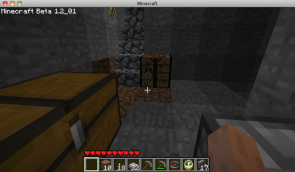
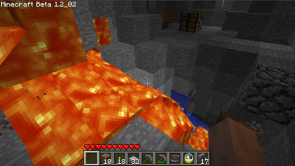
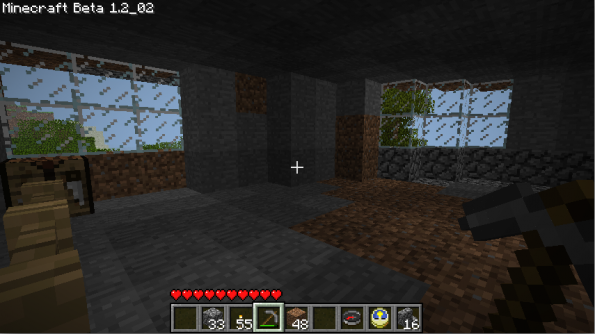
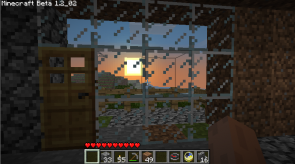
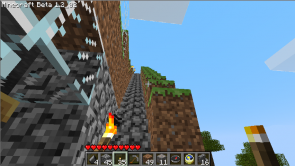

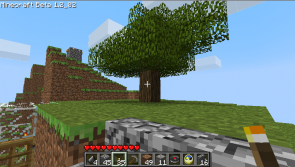

 Posts
Posts
[…] set up an above ground house somewhere (trying to so so in a way that teaches me a bit more about Christopher Alexander), and I want to begin a rail system. The natural direction for rails would be south of my home […]
4/27/2011 @ 9:11 pm
[…] I’ve been meandering around the last month or two trying to figure out what my next Minecraft project should be, but now I think I have a pretty clear plan. I want to turn the back of my home mountain into a railroad station; I’ll build tracks out of that leading to another settlement, and I’ll use that settlement as an opportunity to build an outdoor house or houses, in a way that teaches me more about Christopher Alexander. […]
5/2/2011 @ 3:08 pm
[…] I’ve written about it quite a bit in my diaries on my other blog, and I’ve written a couple of posts here about it that I’m rather fond of; the Playable Characters folks were even kind […]
8/9/2011 @ 9:41 pm